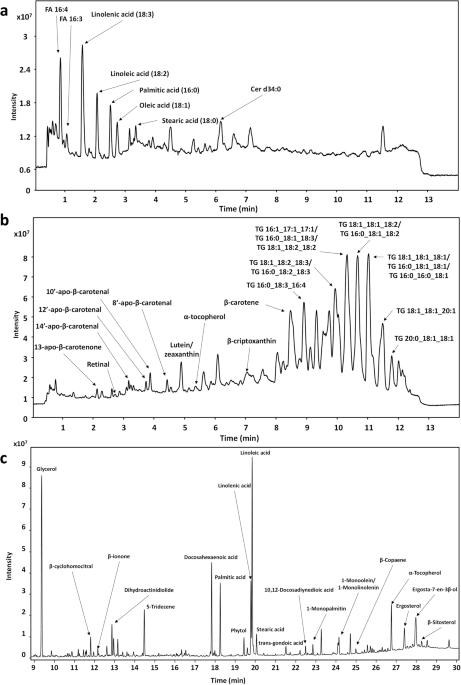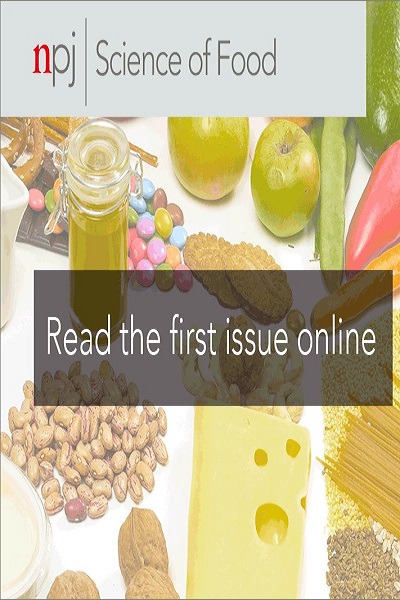杜纳藻提取物的体内神经保护能力--转录组学和代谢组学综合研究
IF 7.8
1区 农林科学
Q1 FOOD SCIENCE & TECHNOLOGY
引用次数: 0
摘要
本研究对利用超临界流体获得的杜莎藻(Dunaliella salina,DS)微藻提取物进行了详尽的化学特征描述,并利用秀丽隐杆线虫(Clenorhabditis elegans,CL4176 株)的阿尔茨海默病(Alzheimer's disease,AD)转基因模型对其体内神经保护能力进行了评估。所研究的 DS 提取物中注释了 350 多种化合物,其中含量最高的是三酰甘油、游离脂肪酸 (FAs)、类胡萝卜素、类胡萝卜素和甘油。DS 提取物能以剂量依赖性的方式明显保护秀丽隐杆线虫免受 Aβ 肽麻痹毒性的伤害。选择这一浓度是为了利用先进的分析方法进一步评估 26 小时后转录组学和代谢组学的变化。RNA-Seq 数据显示,150 个基因发生了变化,主要与应激和解毒反应以及视黄醇和脂质代谢有关。通过全面的代谢组学和脂质组学分析,确定了 793 种细胞内代谢物,其中 69 种与未处理的对照组动物相比发生了显著变化。在这些代谢物中,有不同的不饱和脂肪酸、溶血磷脂酰乙醇胺、核苷、二肽和修饰氨基酸,以前曾有报道称这些物质在 AD 进展过程中有益。这些化合物可以解释所观察到的神经保护能力,从而为这种前景广阔的提取物的保护机制提供了新的证据。本文章由计算机程序翻译,如有差异,请以英文原文为准。

In vivo neuroprotective capacity of a Dunaliella salina extract - comprehensive transcriptomics and metabolomics study
In this study, an exhaustive chemical characterization of a Dunaliella salina (DS) microalga extract obtained using supercritical fluids has been performed, and its neuroprotective capacity has been evaluated in vivo using an Alzheimer’s disease (AD) transgenic model of Caenorhabditis elegans (strain CL4176). More than 350 compounds were annotated in the studied DS extract, with triacylglycerols, free fatty acids (FAs), carotenoids, apocarotenoids and glycerol being the most abundant. DS extract significantly protects C. elegans in a dose-dependent manner against Aβ-peptide paralysis toxicity, after 32 h, 53% of treated worms at 50 µg/mL were not paralyzed. This concentration was selected to further evaluate the transcriptomics and metabolomics changes after 26 h by using advanced analytical methodologies. The RNA-Seq data showed an alteration of 150 genes, mainly related to the stress and detoxification responses, and the retinol and lipid metabolism. The comprehensive metabolomics and lipidomics analyses allowed the identification of 793 intracellular metabolites, of which 69 were significantly altered compared to non-treated control animals. Among them, different unsaturated FAs, lysophosphatidylethanolamines, nucleosides, dipeptides and modified amino acids that have been previously reported as beneficial during AD progression, were assigned. These compounds could explain the neuroprotective capacity observed, thus, providing with new evidences of the protection mechanisms of this promising extract.
求助全文
通过发布文献求助,成功后即可免费获取论文全文。
去求助
来源期刊

NPJ Science of Food
FOOD SCIENCE & TECHNOLOGY-
CiteScore
7.50
自引率
1.60%
发文量
53
期刊介绍:
npj Science of Food is an online-only and open access journal publishes high-quality, high-impact papers related to food safety, security, integrated production, processing and packaging, the changes and interactions of food components, and the influence on health and wellness properties of food. The journal will support fundamental studies that advance the science of food beyond the classic focus on processing, thereby addressing basic inquiries around food from the public and industry. It will also support research that might result in innovation of technologies and products that are public-friendly while promoting the United Nations sustainable development goals.
 求助内容:
求助内容: 应助结果提醒方式:
应助结果提醒方式:


